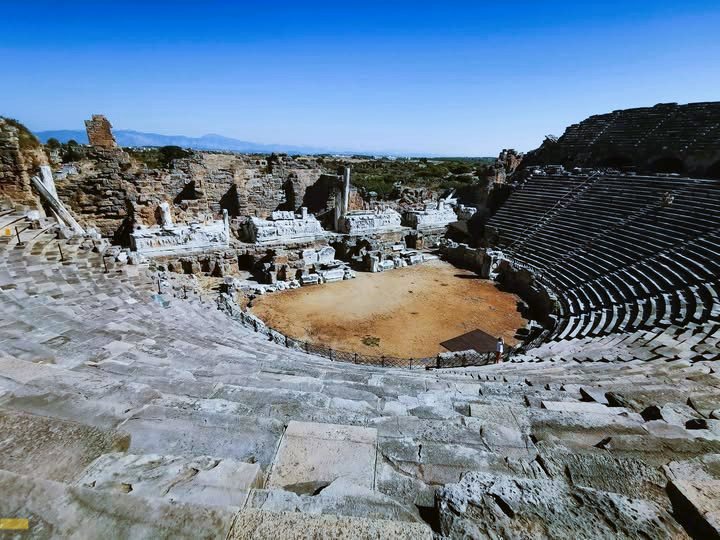•Located in Side a city on the southern Mediterranean coast of Turkey.
•Side was founded by Greek settlers in western Anatolia, this most likely occurred in the 7th century BC, Its main deity was Athena.
•The theatre is the greatest preserved historical building in the city.
•It was built in the middle of the 2nd century AD, on the site of an earlier Hellenistic theatre.
•It has a seating capability of 15,000–20,000 people.

•The outer façade of the theatre was once two-storied, but only its lower part is still intact.
•The skene building (a structure at the back of a stage), was 63 meters (206 feet) long and had 3 stories that formed an ornamental façade, decorated with columns, niches, statues, and reliefs.
•There were nine interconnected rooms on the lowest level of the skene.![]() In the late Roman Empire times, gladiatorial combats and shows with wild animals became more popular, so the theatre was modified a thick wall separating the audience from the orchestra, was added.
In the late Roman Empire times, gladiatorial combats and shows with wild animals became more popular, so the theatre was modified a thick wall separating the audience from the orchestra, was added.

Description:
This ancient theater, located in the narrowest point of the peninsula where the ruins of ancient Side are scattered, is the greatest of the preserved historical buildings of this magnificent city. A few years ago the theatre was closed to the public due to an extensive renovation, but now it is again open for visitors. If you happen to be in Side, make sure you will not miss it, as it is one of the finest Roman theatres in Turkey.
The theatre was built in the middle of the 2nd century AD, on the site of an earlier, Hellenistic, theater. It represents the Roman type of theaters, because it was built on the foundations supported by the barrel vaults. However, the influence of Greek architecture is also visible, for instance in the shape of the audience which is a sector of a circle greater than 180 degrees. The outer façade of the theater was once two-storied, but only its lower part, decorated with arcades, is now visible.
The stage of this theatre consisted of a building called skene and a podium (proskeon) where the spectacles were organized. The skene building, 63 meters (206 feet) long, had three stories that formed an ornamental façade, decorated with columns, niches, statues and reliefs.
There were nine interconnected rooms on the lowest level of skene. The traces of the stairs leading to the upper floors have been discovered in two of them. Additionally, three corridors provided the entrance to the skene building directly from the agora, situated next to the theatre. The actors got to the podium through five gates.
The podium was 6 meters (20 feet) wide and it was 3 meters (10 feet) above the semi-circular orchestra, located between the stage and the audience. The base of the podium, visible above the orchestra, was decorated with reliefs depicting various scenes from Greek mythology. Unfortunately, the state of the reliefs preservation is very poor.
The theater in Side could accommodate up to 15 thousand people. The audience is divided into two parts, by a horizontal pᴀssage called diazoma. In the lower part there are 22 rows of seats, separated into 11 sectors. In the upper part there were originally 29 rows of seats, but the highest of them have not been preserved to the present times.
When, in the late Roman Empire times, gladiatorial combats and shows with wild animals became more popular, the theater was modified to better suit the needs of these forms of entertainment. A thick wall, separating the audience from the orchestra, was added. This wall not only protected spectators against accidents, but also enabled filling the orchestra with water and organizing the scenes of sea battles.
In the 4th century AD the skene building was used as an internal fragment of the city walls, which divided Side into two parts at the narrowest point of the peninsula. According to inscriptions found in the theatre, in the end of 5th century AD the building was transformed into an open-air church. Two small chapels decorated with paintings, located at both ends of the audience, as well as inscriptions on the seats, indicating the places reserved for priests, are the evidence of this modification.
Image gallery:

























